| Botanical Name |
|
| Family |
Xanthorrhoeaceae - |
| Pronunciation |
ny-FOE-fee-ah ROO-puh-rye |
| Common Name(s) |
English: Winter Poker; Spring torch lily
IsiZulu: Icacane; Umathunga Ompofu
|
| Plant Group |
- Bulb / Corm / Rhizome / Tuber / Epigeal bulb Bulbs: are made up of fleshy scales as in an onion
Corm: a short, swollen, underground stem that is hard and not fleshy as in a gladiolus
Tuber: a solid, fleshy, underground, storage organ as in a potato
Rhizome: an underground, horizontal, swollen stem at the base of the plant as in an iris
Epigeal bulb: bulbs that rest above the ground with only the roots anchoring the plant to the earth as in albuca
|
| Plant Size |
- Large
| Tree | 18m to 25m |
| Shrub | 3m to 4m |
| Perennial/ground cover | 75cm to 1m |
| Bulb | 80cm to 1.2m |
| Succulent | 1m to 1.5m |
|
| Position |
- Light or Dappled Shade Found below trees with sparse, open foliage. Ideal for the protection of herbaceous plants.
- Partial Shade The area is in shade for part of the day and in full sun for part of the day.
- Sun The area is in full sun for all or most of the day, all year round.
|
| General Information |
- Drought Tolerance: Moderate The plant is moderately adapted to arid conditions and can survive short periods of drought and high temperatures without extra water.
- Evergreen Plants that have leaves all year round.
- Frost: Half-hardy The plant is able to survive low temperatures and some frost but requires protection against severe frost.
- Water Loving Plants need a regular supply of water and must not be allowed to dry out for any length of time.
- Wind Tolerant Plants able to withstand the effect of strong winds.
|
| Specific Information |
Kniphofia rooperi is native and endemic to the coastal marshes of the Eastern Cape and KwaZulu-Natal. In place of the elongated orange to red blooms that top many other Kniphofia varieties, the flowers are rounded and often flattened at the top, with lime yellow blooms that are burnished with orange as they mature. This is an ideal species to plant in a mini-wetland or in containers in a pond, but will also thrive in drier habitats. It is grown in the UK and the USA and proven to be frost hardy to -9C.
|
| Ad Break |
|
| Flowers |
| Description |
rounded head of tightly packed tubular-shaped flowers on stout stems about a meterlong
|
| Season |
- Winter Plants will seldom bloom for the entire season as given in the list, but should flower during a period within these parameters.
|
| Colour |
|
| Growth Rate |
- Moderate Specifying growth rate can be very misleading as there is considerable variation of growth rate depending on type and species of plant, available water, supplementary feeding, mulching and general care, as well as the plants suitability and adaptability to the garden environment.
|
| Plant Uses |
- Accent or Focal Point A plant used to attract the attention because of its colour or form.
- Attracts bees, butterflies or other insects This plant attracts insects which can be food for birds or other creatures in your garden.
- Attracts Birds This plant will attract birds.
- Border A strip of ground, at the edge of a driveway or path in which ornamental plants or shrubs are planted.
- Boundary A plant useful for planting around the edges of the property to form a green or colourful backdrop, an impenetrable hedge, to hide walls or create privacy.
- Container Trees, shrubs and ornamental species that can adapt to growing in a restricted environment.
- Cut Flowers Plants that provide flowers suitable for ornamental uses.
- Filler Either a fast growing tree or shrub used temporarily to fill in an area while the permanent plants grow to a desired size, or a plant used to fill gaps in borders or beds.
- Mass Planting Plants useful for filling a large area with just one or a few kinds of plants spaced close together. Creates a bold, dramatic effect and to reduces maintenance.
- Suitable for coastal gardens Plants adapted to dry, sandy soil, forceful wind, limited rainfall and intense sunlight.
- Suitable for seaside gardens Plants that will survive the hostile environment of harsh salty winds, dry sandy soil, irregular rainfall and heat found in seaside gardens.
- Water Features These plants may have dramatic, lush foliage or graceful form. They do not shed excessive leaves and do not have invasive root systems.
- Wild Garden An indigenous garden planted for the benefit of wildlife and birds. Provides food, water, a variety of mini-biomes and no poisonous chemicals are used.
|
| Distribution and Habitat |
in the Eastern Cape and KwaZulu-Natal, in marshy places
|
| Planting Suggestions |
Kniphophia rooperi likes its head in the sun and its feet in the water. Prepare the site by mixing good garden soil with plenty of compost, well matured manure and fertiliser of your choice. This species needs plenty of water, especially during the growing season.
The specimens in my garden are in well drained soil and I often neglected to water them as much as I thought they would need. However, as evidenced by the photos, they suffered no harm and flowered prolifically.
|
| Medicinal Uses |
|
| Ad Break |
|


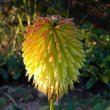
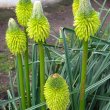
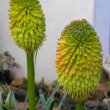
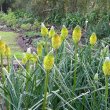
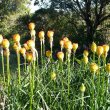
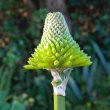
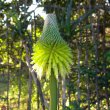
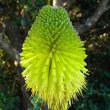


Comments
Kniphophia rooperi
K rooperi is a welcome sight when it flowers in early spring.In my experience it appears to need a clay-rich soil, sun and water from the end of August just before it flowers in mid-September. After flowering it seems to look after itself quite nicely albeit a rather untidy plant.
In a previous location it flowered once but never again. Relocating in April 2013 a small clump tried to flower in Sept 2013 but the flowers were all twisted and distorted. Recently, Sept 2014, the same clump has three perfect flowers in bloom.
Hi Guy
Hi Guy
Thanks for your comment. I have just recently separated and moved my plants. Some of them are flowering, but the flowers are very small and as with yours, some are a bit twisted. I am confident they will be fine by next season.
Yes they do like a clay soil. In fact they grow in our local stream, deeply embedded in clay.
I think this is the prettiest of the Kniphofia genus - neat heads and unusual colour.
Kind regards
Lorraine
Thanks and good luck with
Thanks and good luck with yours. Many kniphofia species have been driven close to extinction by cattle trampling on them in their quest for water. K typhoides was common around seasonal wetlands of the Transvaal Highveld in the fifty's but now they are almost extinct due to trampling by cattle.
PS Where is Kumbula located?
Location of nursery
Hi Guy
The nursery was in Bathurst in the Eastern Cape but due to the collapse of our borehole, we have had to close - no municipal water in our little village.
Kind regards
Lorraine
Location of nursery
We go to Grahamstown every year for the festival and usually take a day off to visit the seaside and usually pop in to Bathurst for a cup of coffee and a bun. If we are in your locality we'll look you up if that is OK with you.
Guy
Hi Guy
Hi Guy
It would be great to meet you, but do remember that the nursery itself is closed. The garden though, is always interesting.
Kind regards
Lorraine
Discuss this plant
Share knowledge, ask a question or give an experience.